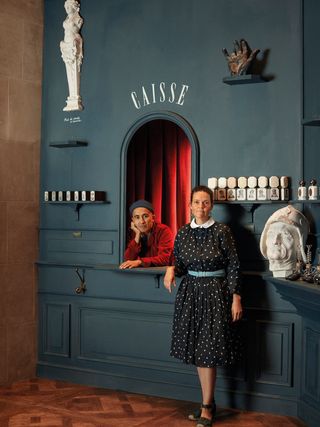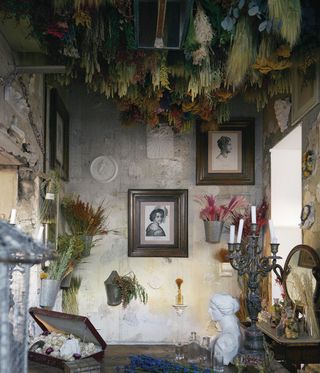Ramdane Touhami on design in the reinvention of Buly 1803
In an exclusive interview, Ramdane Touhami shares the story behind his redesign of the historic brand, Officine Universelle Buly 1803

Ramdane Touhami is one of the most innovative designers working in the beauty industry today, spearheading the rebrand of Cire Trudon before recalibrating the aesthetic identity of Officine Universelle Buly 1803, the brand he relaunched in 2014 along with Victoire de Taillac.
Under Touhami and de Taillac’s guidance, the 19th-century pharmacy has turned into a veritable Wunderkammer of strange and dazzling products from around the world. Think volcanic stone from Sicily that is used to remove calluses, precious perfume vials from the oldest porcelain manufacturer in Japan, Brazilian Tucuma seed oil for preserving your tan, and more.

Perfume dispensers at Buly 1803 store
The brand is also a purveyor of innovative skincare that revives the use of age-old products such as multipurpose clays and natural powders for hair, mouth, and face. It also boasts a fragrance range that features a collaboration with the Louvre; and has created scented stickers that serve to perfume your face mask.
Now, Touhami is launching The Beauty of Time Travel: Officine Universelle Buly and the Work of Ramdane Touhami, a brilliant 400-page book that takes readers through his reinvention of the historic brand, spanning everything from his management philosophy to the typeface used on their Buly 1803 products.
Here, Touhami breaks down some of the guiding principles of the book and shares his thoughts on successful design.
Ramdane Touhami on the fight against aesthetic globalisation
Each of Buly 1803’s shops is unique, reflecting in some way the aesthetic heritage of the city in which it is located. For Touhami, this is an essential element of creating a successful retail empire.

Buly 1803 Tokyo, Daikanyama shop
‘Any retail operation should necessarily take into account the specificity of the cities and regions in which the brand is located,’ says Touhami. ‘This intellectual effort, as much as graphic, is essential to feel a marketing success. Would it not be a proof of intelligence to look around, to incorporate the existing?
Wallpaper* Newsletter
Receive our daily digest of inspiration, escapism and design stories from around the world direct to your inbox.
‘Following this path anchors the Officine Universelle Buly in people's consciousness. If we set up in Toulouse or a certain district of Tokyo, it seems pragmatic to me to use red brick, like that found in the city. If I go to London, I will incorporate Victorian [influences]. Art deco in New York. Globalised stores as we know them should take into account this element of regional decor in their international strategies.’
Typography is fundamental to brand identity
For Touhami, every element of Buly 1803's identity has to be considered, right down to the typography, which he designs specifically for the brand.

Ramdane Touhami and partner Victoire de Taillac in one of Buly 1803's shops
‘[People] have only been relying on standardised graphic elements for 50 years. Back in 1929, when Mies Van der Rohe designed his Barcelona Pavilion, all the furniture was conceived. Look at Perriand or Le Corbusier – the concept was total, from A to Z, as brand identities should be. Typography, graphic elements, furniture, lighting, all thought out and developed with one goal in mind: to beat the competition and assert its own identity,’ says Touhami.
'You have to be careful never to fall into a typographic routine. I have always tried to surprise in a particular style (1930s, 1950s), while maintaining a semblance of consistency. The art of adjustment! One should not remain fixed on one's achievements; permanent evolution remains the key.'
The past is necessary for innovation in the present
'My motto is: one foot in the future, one foot in the past. You have to go in search of the right balance. Copying and pasting is never very attractive. You have to give the impression that the brand has gone through different times, different eras,' says Touhami.

'A brand from the 19th century has inevitably evolved over time. You have to be able to feel the history in your products, and especially when you see them.'
Successful design is...
'Popular. It must appeal to the greatest number of people. Especially in terms of sales. It is a balance between aesthetic success and commercial success.'

'But above all, the person who makes it must be happy, as well as the person who sells it and the person who distributes it. It is a pledge of authenticity and truth, which are the basis of a Japanese philosophy of life called honmono. It definitely produces good design!'
Touhami’s most surprising discovery was...
Touhami regularly travels around the world in search of little known beauty rituals and ingredients. His discoveries are the key to Buly 1803’s vast and fascinating product range. Of all his findings, he says, his most surprising was powdered nightingale droppings in Japan.

Buly 1803 combs sourced from around the world
‘[It has] healing and anti-wrinkle properties for the epidermis,’ he says of the use of the unusual and traditional ingredient. ‘It is urgent to promote these beauty treasures, which naturally [work] for our benefit.’
INFORMATION
Mary Cleary is a writer based in London and New York. Previously beauty & grooming editor at Wallpaper*, she is now a contributing editor, alongside writing for various publications on all aspects of culture.
-
 Apple’s new Mac mini is a pocket-sized powerhouse thanks to the M4 processor
Apple’s new Mac mini is a pocket-sized powerhouse thanks to the M4 processorWith the new Mac mini, Apple has squeezed its M4 and M4 Pro processors into the smallest conceivable footprint, physically and environmentally. Apple insiders tell us how
By Jonathan Bell Published
-
 One to Watch: EJM Studio’s stool is inspired by the humble church pew
One to Watch: EJM Studio’s stool is inspired by the humble church pewEJM Studio’s ‘Pew’ stool reimagines the traditional British church seating with a modern, eco-conscious twist
By Smilian Cibic Published
-
 Hong Kong brutalism explored: tour the island with this new architectural map
Hong Kong brutalism explored: tour the island with this new architectural mapHong Kong brutalism is brought into sharp focus through the launch of Brutalist Hong Kong Map, the latest of its kind in publisher Blue Crow Media’s 20th-century architecture series
By Yoko Choy Published
-
 Bastille Parfums: the French fragrance house blending technology with olfactory craft
Bastille Parfums: the French fragrance house blending technology with olfactory craftBastille Parfums is on a mission to shift the perception of high-end fragrance
By Mary Cleary Published
-
 Amen’s new collection takes on abstract, sculptural forms handcrafted by Katharina Kaminski
Amen’s new collection takes on abstract, sculptural forms handcrafted by Katharina KaminskiAmen candles officially launches its new series of figurative light sculptures, ‘Luminous Beings’
By Mary Cleary Last updated
-
 Take a tour of Louis Vuitton's fragrance house
Take a tour of Louis Vuitton's fragrance houseMaster perfumer Jacques Cavallier Belletrud offers a peek inside Les Fontaines Parfumées
By Mary Cleary Last updated
-
 New French fragrance maison Ormaie references modernist design greats
New French fragrance maison Ormaie references modernist design greatsBy Elly Parsons Last updated
-
 Top of the glass: Pauline Deltour’s first design for Cire Trudon has serious bottle
Top of the glass: Pauline Deltour’s first design for Cire Trudon has serious bottleBy Elly Parsons Last updated
-
 Hermès gallops in with a new equestrian themed fragrance
Hermès gallops in with a new equestrian themed fragranceBy Christopher Stocks Last updated
-
 Les Bains Guerbois launches its 'subversive' fragrance line
Les Bains Guerbois launches its 'subversive' fragrance lineBy Jean Grogan Last updated
-
 Parisian pedigree: L’Artisan Parfumeur relaunches its classic French fragrance line
Parisian pedigree: L’Artisan Parfumeur relaunches its classic French fragrance lineBy Christopher Stocks Last updated